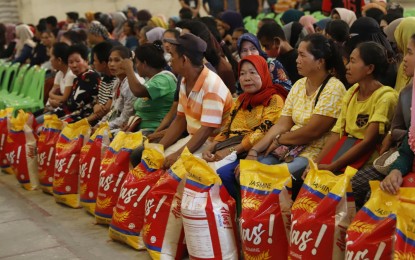
GOV’T ASSISTANCE. Registered beneficiaries of the Pantawid Pamilyang Pilipino Program, a conditional cash transfer scheme for the poorest of the poor sector, receive free sacks of imported rice at the National Food Authority warehouse in Zamboanga City on Tuesday (Sept. 19, 2023). President Ferdinand R. Marcos Jr. led the distribution of about 1,500 sacks, which were among the 42,180 sacks confiscated by the Bureau of Customs during a raid in Barangay San Jose Gusu. (PNA photo by Alfred Frias)
MANILA – President Ferdinand R. Marcos Jr. said Tuesday he is optimistic that he would attain his goal of bringing down the price of rice to PHP20 per kg.
In a media interview on the sidelines of the distribution of confiscated sacks of imported rice in Zamboanga City, Marcos raised the likelihood of reducing prices once the agriculture sector and the cost of production in the country become stable.
“May chance lagi ‘yan (There is always a chance),” the President said when asked by media if the PHP20 per kg. of rice remains feasible.
Marcos said several factors happening outside the Philippines are directly affecting the prices of basic commodities, prompting the government and the market to adjust.
He said the government could make the necessary adjustments in the prices of rice once everything normalizes.
“Kapag talaga nagawa natin ang cost of production, binaba natin, ay bababa rin ang presyo ng bigas. Bababa rin lahat. Basta’t mas mataas ang ani kahit na pwede nating ipagpantay ang presyo (If we reduce the cost of production, the price of rice would also decrease. Everything will go down. We should have a higher yield that could match the price),” Marcos said.
“Pagka naging mas normal na ang sitwasyon, malaking pag-asa talaga natin na ibababa natin ang presyo ng bigas (Once the situation becomes more normal, we really have high hopes that we can reduce the price of rice).”
He assured that the government is exhausting all remedies to make the prices of rice affordable for the Filipino people, especially for those who find it difficult to make ends meet.
Necessary measures are in place to ensure a reasonable buying price for farmers, he said, noting that the National Food Authority (NFA) Council has set a new price range for the purchase of palay (unhusked rice).
The NFA Council, chaired by the President, approved Monday the buying price range of PHP16 to PHP19 for wet palay and PHP19 to PHP23 for dry palay.
Mitigation plan
Meanwhile, Marcos said his administration would address flooding by establishing multi-use infrastructures and improved weather forecasting to lessen its impact on communities and the agriculture sector.
He said concerned agencies, such as the Department of Science and Technology and the Philippine Atmospheric, Geophysical and Astronomical Services Administration, are working together to control flooding.
“‘Yun lamang at talagang kailangan tingnan nang mabuti kung ano ‘yun magiging weather, kaya’t kasama rin diyan hindi lamang sa flood control… nagbago na hindi lang ‘yung paglagay ng dike, hindi lang ‘yung paglagay ng dam, kung hindi pati na ang pagbantay nang mabuti sa panahon (That is all, and it is really necessary to look carefully at what the weather will be like, so that includes not only flood control... It is not just the placing of the dike, it is not just the placing of the dam, but also the close monitoring of the weather),” Marcos said.
Climate change is already taking its toll on communities, he said, adding that the changing weather patterns already affect places that do not usually experience flooding in the past.
He said the government must build flood control infrastructures with “multiple functions.”
“Ang flood control ngayon natin hindi na lang flood control. ‘Yung mga dam at saka ‘yung mga spillway para kunin ‘yung tubig. Ang bagong gawain natin ngayon ay number one, gagawa tayo… meron tayong ilalagay na dam, meron ding pagkukuhanan ng tubig para sa mga magsasaka, pang-irrigation, meron… may ganoon (Our current flood control is no longer just flood control. The dams and the spillways would collect the water. Our new task now is number one, we will put a dam. There will also be water supply for the farmers, irrigation),” Marcos said.
“’Yung iba naman para mabawasan ang baha ay maglalagay tayo ng tinatawag na impounding pools. In other words, maghuhukay tayo, doon natin iiipon ‘yung tubig. Maganda ‘yan dahil unang-una hindi nasasayang ‘yung tubig, may iiwan doon sa atin. Tapos pagka medyo tuyo, pag hindi na umuulan, gamitin natin ‘yung tubig para pang-irrigation ulit, puwede pang lagyan ng isda (The other way to control the flood is to put what we call impounding pools. In other words, we will dig up, that is where we will collect the water. That is good because first, the water will not go to waste as something will be left there for us. Then when it is a bit dry, when it stops raining, let us use the water for irrigation again and we can also put fish).”
Marcos earlier created the Water Resources Management Office (WRMO) tasked to draw up a comprehensive plan to prevent flooding in Metro Manila and coastal communities.
The WRMO, under the Department of Environment and Natural Resources, will also address the country’s water and sanitation sector, climate change impact, lack of water infrastructure, increasing water demand due to population and economic growth, as well as regulation issues. (PNA)
